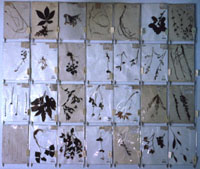Slag Wall
 Slag
is a by-product of the steel making industry. For each ton of steel a ton to
a ton and a half of slag was produced. Slag is an inefficient soil medium for
establishing plants. Its steep slopes, porosity and typically high pH create
a challenging environment for plants to establish themselves.
Slag
is a by-product of the steel making industry. For each ton of steel a ton to
a ton and a half of slag was produced. Slag is an inefficient soil medium for
establishing plants. Its steep slopes, porosity and typically high pH create
a challenging environment for plants to establish themselves.
In light of this, Pittsburgh City
Planning approached the Environmental Protection Agency with a proposal to develop
a multi-tiered experiment to understand the potential for revegetating steep
slag slopes without incurring the costs and disruption to the tenuous ecosystem
of additional grading. The upper slopes, graded by the developers for the housing
development, will receive an expensive but well thought out soil and vegetation
planting. A research team led by soils scientist John Buck of Civil and Environmental
Consultants, with botanist Sue Thompson of the Carnegie Museum of Natural History
and members of the STUDIO, developed a greenhouse study and on-site test plot
program. The intent of the study was to outline a program of successful low
maintenance revegetation, which targets soil remediation and a vegetation mix
which provides maximum habitat value and aesthetic opportunity through the use
of native plants.
 Some
of the plant specimens discovered onsite by Sue Thompson were pressed and displayed
on the wall. On the table were two examples from the actual greenhouse study,
cared for and managed by Reiko Goto. The accompanying video
by Bob Bingham illustrates the conditions and changes that are occurring
on the slag slopes today as nature struggles for a foothold and the development
proceeds with its site preparation.
Some
of the plant specimens discovered onsite by Sue Thompson were pressed and displayed
on the wall. On the table were two examples from the actual greenhouse study,
cared for and managed by Reiko Goto. The accompanying video
by Bob Bingham illustrates the conditions and changes that are occurring
on the slag slopes today as nature struggles for a foothold and the development
proceeds with its site preparation.
This year's growth has been constrained
by the recent drought, but as a long term sustainable ecological restoration,
the plants are selected for their ability to weather such conditions. Seeds
which have not germinated this year will continue to be viable next year.
Nine
Mile Run Greenway Project
STUDIO for Creative Inquiry
Carnegie Mellon University
 Slag
is a by-product of the steel making industry. For each ton of steel a ton to
a ton and a half of slag was produced. Slag is an inefficient soil medium for
establishing plants. Its steep slopes, porosity and typically high pH create
a challenging environment for plants to establish themselves.
Slag
is a by-product of the steel making industry. For each ton of steel a ton to
a ton and a half of slag was produced. Slag is an inefficient soil medium for
establishing plants. Its steep slopes, porosity and typically high pH create
a challenging environment for plants to establish themselves. Some
of the plant specimens discovered onsite by Sue Thompson were pressed and displayed
on the wall. On the table were two examples from the actual greenhouse study,
cared for and managed by Reiko Goto. The accompanying
Some
of the plant specimens discovered onsite by Sue Thompson were pressed and displayed
on the wall. On the table were two examples from the actual greenhouse study,
cared for and managed by Reiko Goto. The accompanying